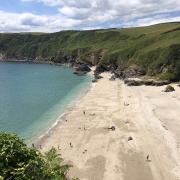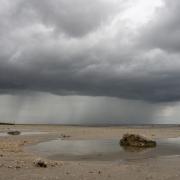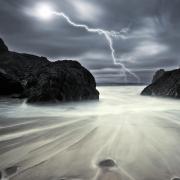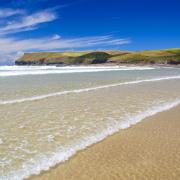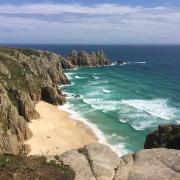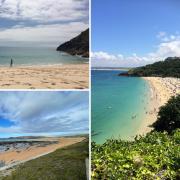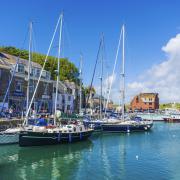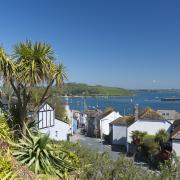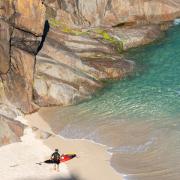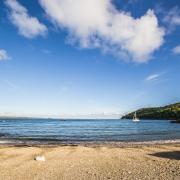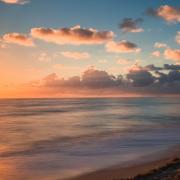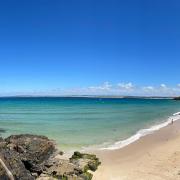The mighty Falmouth Harbour is said to be the deepest natural harbour in Western Europe and the third deepest in the world, writes David Chapman.
When we speak about ‘Falmouth Harbour’ in this way we are actually talking about the natural sanctuary offered by The Carrick Roads rather than the docks and quays in the town of Falmouth.
To understand how the River Fal, a small river by any standards, has created such a deep natural inlet we have to go back tens of thousands of years. When we were going through a period of Ice-Ages the sea level was much lower and Falmouth (if it had existed) would have been a long way from the coast.
Even within the Ice-Age periods of thaw occurred and at times the River Fal would have been a raging torrent of water gradually eroding out a deep, steep-sided, V-shaped valley. Since then the sea level has risen and the valley has become permanently flooded, quickly reaching a significant depth in the area we now call The Carrick Roads. This flooded valley is known as a ria and this process explains why we see oak trees dipping their branches into the salt water at high tide. Over time those oak trees will be submerged and the line above them will have their roots washed by the sea.

Being such a deep natural harbour in the far south west of England Falmouth Harbour has long been of significant strategic importance and this is why the area is surrounded by some of the most impressive military defences of the whole British coastline. Pendennis and St Mawes Castles were built in the reign of Henry VIII between 1539 and 1545 to defend against attack or invasion by the Spanish and French who had fallen out with Henry over his shunning of the Catholic faith.
Pendennis Castle was designed in a circular pattern to allow guns to be placed facing in every direction and they were fixed at various levels. It was garrisoned by up to a hundred men at times of greatest threat. St Mawes Castle was also bristling with armaments and both were continuously armed with various weaponry from the time of their evolution until 1956, an incredibly long-lasting testament to the importance of this harbour.
Probably the nearest any foreign force came to invading was in 1596 when the Spanish Armada planned to take Falmouth but they were foiled by bad weather. Further threats from the French and Dutch ensured that the protection of the area remained a top priority.

It is quite surprising that during the initial fortification of Pendennis Falmouth didn’t even exist as a major settlement. The main town of the area was at Penryn, which was established in the 13th Century. Falmouth wasn’t established until 1613, the initial activity here was instigated by Sir John Killigrew and so successful was he that Falmouth received its Royal Charter as early as 1661. The Customs and Excise moved to Falmouth from Penryn in 1650 and in 1688 Falmouth was made the Royal Mail Packet Station. For 150 years Falmouth was the only place in the country where the mail was shipped in and out on sail-powered Packet Ships. As a result Falmouth boomed. The work done by the Killigrew family is recognised by the Killigrew Monument near the Maritime car park and there is a Packet Service Memorial (dating from 1898) at The Moor.
The main quay in the early days is known as The Custom House Quay, interestingly here there is a chimney called ‘The King’s Pipe, where illegally imported tobacco was destroyed! This an indication of the prevalence of smuggling in the county even under the noses of the customs and excise.

The docks were first constructed in 1860 and the first vessel to use them was the Frederick VII in 1861. Soon after this the railway opened in 1863 with a direct line to the dockyard making it very easy to import and export goods, though the railway was also significant in attracting tourism to the town. In its heyday, during the 1950’s, the docks employed 3000 people and though its size today is much reduced the dock is still an important local employer. More recently The Pendennis Shipyard was established in 1988 and specialises in the construction of multi-million-pound luxury super yachts. This hints at the importance of Falmouth to the sailing community.
Falmouth Harbour played a role in the First World War acting as a base for the Admiralty but its role in World War II was of much greater consequence. The docks repaired ships damaged in action and there were usually at least a hundred vessels anchored in the wider harbour. The town was bombed twelve times and 31 people were killed.

The harbour was protected by a range of armaments, a submarine net and far to the south, at Nare Point, a decoy site was established. Here a range of lights and fires could be triggered to confuse bomber pilots into dropping bombs there instead of on the town of Falmouth. On the last, and most destructive, bombing raid of Falmouth in May 1944 nine bombs were dropped on Nare Point, possibly saving many lives and much damage.
Probably most significant was the contribution made by the area to the Normandy Landings. American troops embarked from several places in the harbour complex including Falmouth Harbour, Trebah Garden, Turnaware Point and Tolverne. Some 27,000 American troops were based in temporary camps and without warning they all left on the 6th of June 1944. The rest is, as they say, history.

Wherever you may wander in Falmouth you are never far from the water and you are always walking in the footsteps of famous people who have come here to set off on their voyages or simply to be inspired. Charles Darwin, Lord Byron, Florence Nightingale, Kenneth Grahame, Robin Knox-Johnstone are among the many people whose presence has enriched the history of the town.
Tourists are attracted by the beauty of the place as well as its history with many arriving by water. Arguably the best way to arrive is by ferry with boats regularly travelling to and from Truro and St Mawes and it is also possible to take day trips from Falmouth to Trelissick Garden.
Attractions in the town include Pendennis Castle and, adjacent to the harbour, The National Maritime Museum which charts the history of Falmouth’s maritime exploits with exhibits featuring a wide range of subjects including a look at the Packet Ships as well as housing a selection of historic and more modern sailing vessels.

Sailing and history go hand in hand at Falmouth. There can be no better visual link between history and sailing than the visitation of tall ships. The harbour has been chosen to play a part in the Tall Ships races of 1966, 1982, 1998, 2002, 2008, 2014 and it will again host these wonderful vessels in August 2021.
The Tall Ships races offer an incredible opportunity for us photographers to dust off our gear and head out on boats or simply to get out on the coastline to capture a few images for posterity.
In 2014 I was lucky enough to get out for the day on a relatively fast boat which enabled us to keep up with the action as well as switching between the various ships as they progressed out of the Carrick Roads. I was pleased to be taking photos from a boat as it enabled me to get a low viewpoint, this gives these mighty old sailing ships a greater sense of power. Being close I was able to use a wide-angle lens which emphasises their size against the surrounding landscape. Having smaller boats in the same photos didn’t bother me too much as they also help give an important sense of scale.

We were lucky to have a sunny day and a calm sea. Our captain was able to get us into appropriate positions with the sun behind us to capture the best images. As well as trying to get shots of whole ships I was keen to use a telephoto lens to get close in on the rigging with its wonderful shapes and was amazed by the brave people who were climbing around on the masts and yard-arms to unfurl the sails.
I was staggered by the number of vessels at sea as well as the huge number of people watching from viewpoints such as Pendennis and St Mawes but it all helped to make a joyful spectacle. Given the difficult year we have all faced I hope the Tall Ships race of 2021 can bring a similar level of joy and help to lift all our spirits.

Wildlife
There are wildlife-focussed boat trips from Falmouth, these regularly spot breeding seabirds in summer, seals throughout the year as well as sometimes encountering dolphins. Grey seals regularly haul out on Black Rock in the Carrick Roads, they might be seen in the water off Pendennis Point. Peregrines can be seen and heard around the town, check out the viewpoint overlooking Falmouth Docks. The Carrick Roads is a good spot for wintering wildfowl including red-breasted merganser, black-necked grebe and great northern divers. Throughout the year nearby Swanpool is an attractive spot to see a variety of birds.
To see more of David’s photography visit his website at www.davidchapman.org.uk or look out for his book Photographing Cornwall available in all local bookshops.







